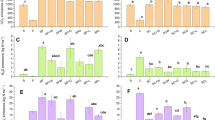Abstract.
Manure N dynamics are affected by manure characteristics, soil factors, and environmental conditions. An incubation experiment was conducted to assess the relationship of these factors. The effects of temperature (11, 18, and 25°C), soil texture (three soils, silt loam to sandy loam), and soil water status (constant at 60% water filled pore space, WFPS, and fluctuating between 30% and 60% WFPS) on net mineralization and nitrification of swine manure N were assessed. Swine manure was applied at an equivalent rate of 350 kg total N ha–1 to 250 g air-dry soil in 2-l canning jars. Subsamples were taken from each jar for NO3 – and NH4 + determination when fluctuating moisture treatment dried to 30% WFPS, with sampling continuing through four wet-dry cycles at each temperature. Manure NH4 + was rapidly nitrified to NO3 –. The relationship between NO3 – accumulation and degree days after application (DDAA, 0°C base) could be described across temperatures using a single pool exponential model for each soil. More NO3 – accumulated in coarser-textured soils (150–200 mg N kg–1 soil), compared to 130 mg N kg–1 soil in the silt loam soil. Fluctuating soil water status did not alter estimates of rate and extent of NO3 – accumulation, but slowed NH4 + disappearance somewhat.
Similar content being viewed by others
Author information
Authors and Affiliations
Additional information
Electronic Publication
Rights and permissions
About this article
Cite this article
Griffin, .T., Honeycutt, .C. & He, .Z. Effects of temperature, soil water status, and soil type on swine slurry nitrogen transformations. Biol Fertil Soils 36, 442–446 (2002). https://doi.org/10.1007/s00374-002-0557-2
Received:
Accepted:
Issue Date:
DOI: https://doi.org/10.1007/s00374-002-0557-2




